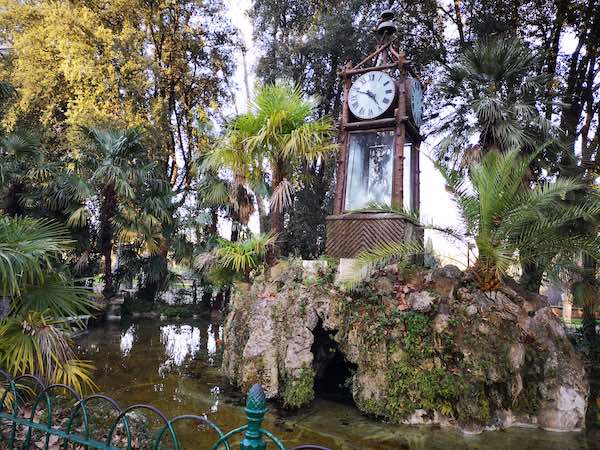All you need to know about the Pincio Water Clock (Orologio ad Acqua del Pincio), one of Rome’s most unique sights. What it is, how to get there, what to see nearby
The Pincio Waterclock (Orologio ad Acqua del Pincio) is a unique outdoor clock in Rome.
It owes its name to the water mechanism that keeps it ticking and it is a fascinating and out-of-the-ordinary thing to see in Rome.
The clock was out of order for many years but it was recently repaired and has been functioning again since January 2022.
This is all you need to know to plan a visit.

Pincio Water clock facts
Name: Pincio Water Clock or, in Italian: Orologio ad Acqua del Pincio. (Orologio = clock; Acqua=water)
Date: 1867
First displayed in the current location: 1873
Author: Father Giovan Battista Embriaco (watch maker); Gioacchino Ersoch (landscaper)
Material: cast iron, glass
Pincio Waterclock Address and how to get there
The Pincio Waterclock is inside the Borghese Gardens and, more precisely, on the Pincio Hill (Pincian Hill), from where it is named.
The address of the clock is Viale dell’Orologio, Villa Borghese.
It is only a couple of minutes’ walk from the famous Pincio terrace, on the western end of the park.
To get there, follow Viale dei Bambini until you see a merry-go-round on one side and a café on the other: the clock is less than 100 meters from the café, on the same side of the road.
To admire it, you only need a couple of minutes but the mechanism that operates is fascinating and the stop will be worth it!

What is the Pincio Water Clock?
The Pincio water clock is a tall, outdoor grandfather clock operated by a hydraulic system. Its creator is Giovanni Battista Embriaco, a Dominican friar who built it in 1867.
Father Embriaco was from Liguria but moved to Rome to join the prestigious dominical institution of Collegio della Minerva, attached to the church by the same name.
Embriaco had a passion for clocks from a very young age.
He was particularly taken by the idea of hydrocrhonometers (water clocks) and sought out support to create one from the prestigious Accademia dei Lincei in Rome.
The support arrived and the Academy recalls that ‘humble […] by nature and by religious profession, Embriaco submits these inventions to our Academy hoping to be encouraged to perfect them and present them publicly’.
A clock prototype was supposed to make its way to the Universal Expo in Paris.
However, the prototype never made it there or, at least it, didn’t make it to the showcase.
Some sources recall it didn’t even make it out of its crate because no one at the Universal Exposition could put it in operation.
The Borghese Gardens house the clock since 1873.
The appearance of the clock is particularly suited to the park and the small island that hosts it blends in perfectly with the feature of this extensive and often extravagant park.

The clock tower is cast iron and recalls the tall trees of the park; the clock faces are reminiscent of tree trunk sections, and the clock arms have plant shapes that once again match its surroundings.
Glass panels allow to peek inside the clock’s mechanism and get a hint of its unique functioning.
The clock is perched on a tiny, fenced artificial island designed by architect Gioacchino Ersoch.
He created a small rocky mount, surrounded by a small water pond and crossed by a wooden bridge.
His idea was to create a romantic, evocative spot where you could only hear the sound of the water and the clock’s chime and, indeed, the place has an unmistakable Nineteenth-century charm.
Fun fact: this is the only water clock in Rome in a public park but not the only hydrochronometer in Rome! A second one is in a private courtyard in Via del Gesu’ and a third one, now displaced, was in the garden of the Ministry of Finance.
How does the Pincio waterclock work
The clock works thanks to the flow of water from the fountain.
Water falls into two leaf-shaped containers balancing on a central point, a little like an old-fashioned scale.
The bowls oscillate, initiating the movement of the clock’s pendulum, which, in turn, charges the clock charm.
Creating a water clock able to accurately tell the time is exceptionally difficult.
As well as the precision always required by watchmakers, the creatures of water ones also need to take into account the changes in temperature of the water and its impact on the speed of the clock.
This extra ordeal makes the achievement of this water clock even more special.
What to see nearby
The clock is inside Villa Borghese and you can easily visit in addition to several attractions in and near the park.
Things we recommend you see are:
Villa Borghese itself a vast park with beautiful walking paths, fountains and cafes
The Borghese Gallery, on the other side of the park, one of the most beautiful art galleries in Rome and the world
The Pincio Terrace, one of the most beautiful viewpoints over Rome from where you see Piazza del Popolo and St Peter’s Dome
Piazza del Popolo, immediately below the Panoramic Pincio Terrace
I hope you enjoyed this quick overview of the Pincio Water Clock and it inspired you to go see it. Safe travel planning!
Orologio ad Acqua del Pincio – Pin this!

